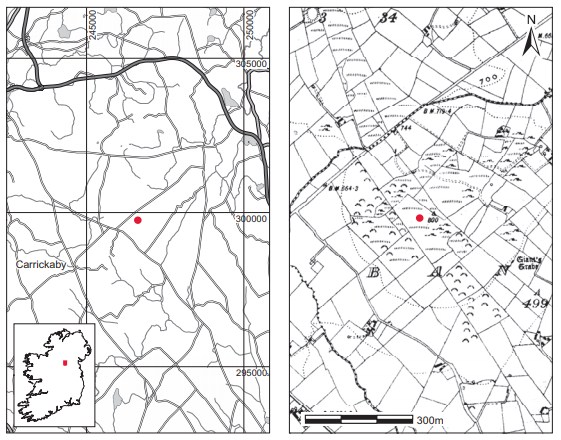County: Cavan Site name: BANAGHER, CO. CAVAN
Sites and Monuments Record No.: SMR CV026-004 Licence number: E1039
Author: JOSEPH RAFTERY
Site type: Early Bronze Age graves
Period/Dating: —
ITM: E 646611m, N 799752m
Latitude, Longitude (decimal degrees): 53.944996, -7.290006
Introduction
The discovery of a pottery vessel and some bones at Banagher, Co. Cavan, was reported to the NMI in January 1972. Dr Joseph Raftery investigated the discovery. This report is based on his field notes. The site was found to be a low mound surrounded by a ring of stones. The discovery had been made when the owner of the land, Mr Edward Conaty, dug into the mound in order to get foundation material for a path.
Location (Fig. 3.13)
The site is in the townland of Banagher, near Carrickaboy, Co. Cavan, at a height of 200–250m above sea level.27 Although unmarked on the OS 6in. sheet, the site is one of three megalithic tombs in the townland, the others being a court tomb and a portal tomb (O’Donovan 1995, 3). The site is described as a passage tomb consisting of a large stone circle within which is a ruined cairn and an undefined chamber structure. There is at least one decorated stone.

Description of site
In his report Dr Raftery described the site as he found it and also recorded details of the burials as described by the Conaty family. An irregular area of c. 10m2 had been opened to a depth of c. 0.8m. It became apparent that the mound was made up of a mixture of dark earth and small stones. The stones were removed by hand. Three ‘cavities’ were discovered but were not visible at the time of the inspection, having been destroyed. They were towards the centre of the mound, and nearby was found a block of stone lying on its side, c. 60cm long and 15cm wide. There were three groups of scored lines on this stone across one of the corners.
Each of the two smaller ‘cavities’ contained a ceramic vessel that was very soft and said to be encased in clay. They both disintegrated when they were taken out. In the third, larger cist, a complete vessel was discovered, apparently mouth upwards in the centre of the cist. There is no reference to the presence of human remains in any of the cists.
Pottery (Fig. 3.14)
The vessel (1973:188) is a necked bipartite bowl, as defined by Ó Ríordáin and Waddell (1993, 174). It has a bevelled rim and a central constriction around the body. The rim is decorated with a zigzag in false relief. The body is decorated with rows of triangular impressions in false relief, followed by rows of horizontal and oblique lines of comb impressions and coarse whipped cord impressions. Near the base is a series of non-contiguous semicircles filled with vertical parallel strokes.

Ext. D 15.1cm; max. ext. D body 15cm; D base 7.1cm; H 11.3cm; av. T of wall 1.1cm.
Comment
As no human remains were recovered it has not been possible to date the site by radiocarbon dating. Based on the type of decorative scheme and motifs, the vessel appears to fit best with Brindley’s stage 3 bowl development, which is dated from 1980 to 1930/20 BC. The evidence suggests that at least three cists were inserted into the mound of a passage tomb, following the practice of later insertion into existing mounds or cairns familiar from other sites such as the Mound of the Hostages at Tara, Co. Meath.
27. Parish of Denn, barony of Upper Loughter. SMR CV026-004——-. IGR 246670 299740.